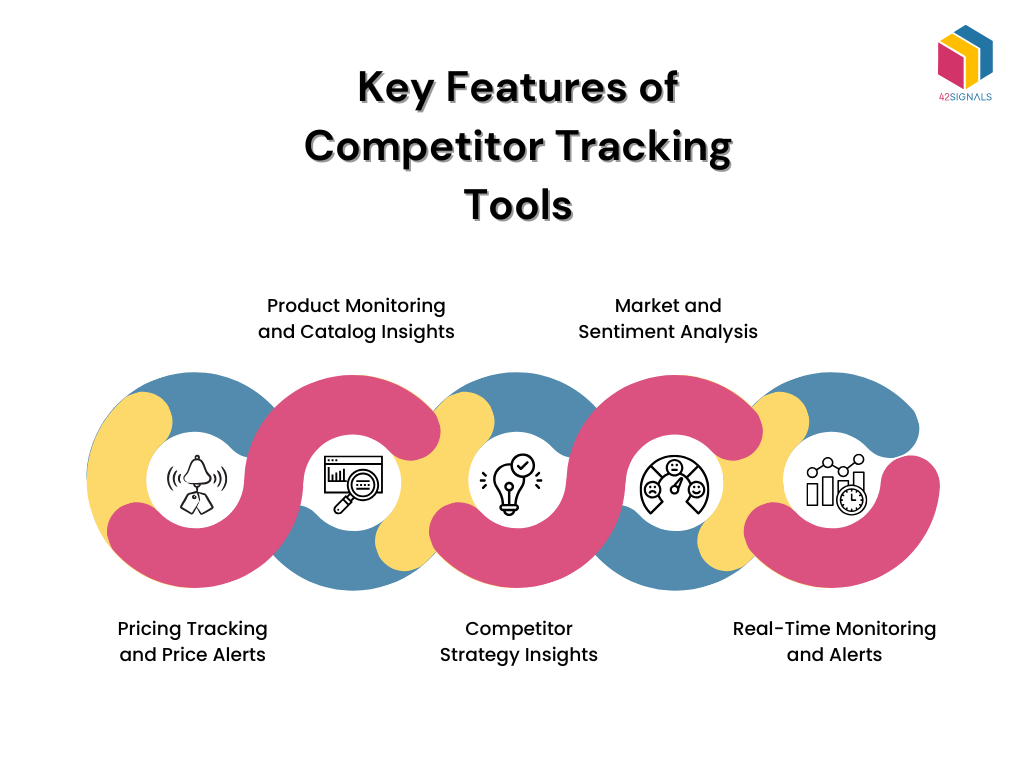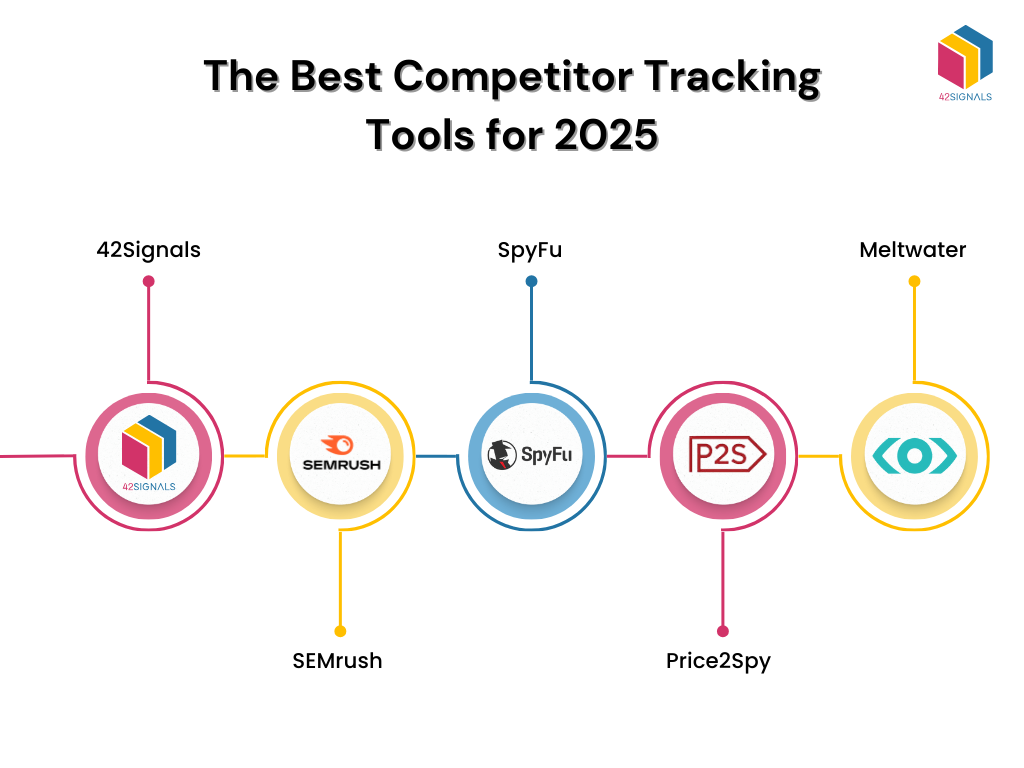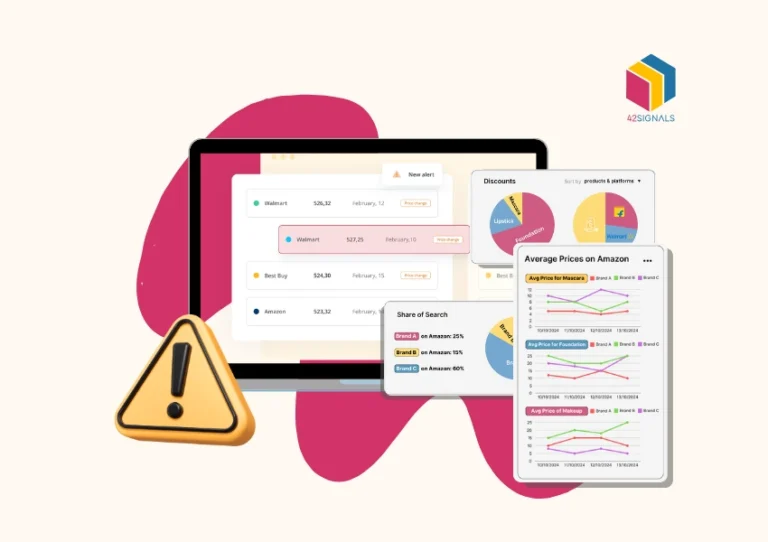Table of Contents
ToggleBrands that understand their competitors’ strategies, pricing, and product offerings are better equipped to adjust and thrive in an increasingly competitive market. One of the best ways to achieve this is through competitor tracking. With advancements in competitor monitoring and the use of competitor tools, businesses can gain valuable insights into their competition and fine-tune their strategies accordingly. In this article, we will explore the importance of competitor analysis, the best tools to perform competitor tracking, and how to implement these insights into your e-commerce strategy in 2025.
What is Competitor Tracking?

Image Source: Mayple
Competitor tracking involves continuously monitoring and analyzing your competitors’ activities and strategies in the market. This includes tracking changes in their product offerings, pricing strategies, promotional tactics, customer engagement efforts, and overall business operations. The goal is to gather valuable intelligence that can inform your own business decisions, helping you stay competitive, adjust your strategies in real-time, and drive growth.
In e-commerce, competitor tracking helps brands adapt to market shifts, identify emerging trends, and react faster to customer demands. With the right tools, e-commerce businesses can take advantage of competitor data to optimize product listings, refine digital shelf strategies, and improve their customer experience.
Why is Competitor Tracking Essential for E-Commerce Brands?
The e-commerce environment is constantly evolving. New technologies, shifting consumer behaviors, and market trends can quickly alter the competitive landscape. To stay competitive, e-commerce brands need to monitor their competitors’ every move. Here are several reasons why competitor tracking is essential:
- Monitor Competitor Pricing: Pricing is a major factor influencing consumers’ purchasing decisions. Tracking competitor prices helps brands adjust their own pricing strategies to remain competitive.
- Understand Product Offerings: Competitor tracking allows you to understand what products your competitors are offering, the features they highlight, and how they differentiate themselves from your brand.
- Analyze Marketing and Sales Strategies: Knowing how your competitors are positioning themselves in the market, their promotional campaigns and even their sales tactics can provide invaluable insights into what works and what doesn’t in your industry.
- Identify Gaps in the Market: By monitoring competitors, you can spot underserved areas or niches that your brand can target. This can help you innovate and differentiate your products from the competition.
- Stay Ahead of Market Trends: Market trends often emerge through shifts in competitor strategies. By keeping an eye on these movements, you can predict future trends and adapt your own strategy proactively.
Top Features to Look for in Competitor Tracking Tools

As the e-commerce landscape evolves, brands are increasingly turning to sophisticated competitor tracking tools to streamline their market intelligence efforts. Here are some of the essential features that modern competitor analysis software offers:
1. Pricing Tracking and Price Alerts
Price monitoring is a critical aspect of competitor tracking. Competitor price tracking tools can help you monitor competitor pricing in real time, enabling you to adjust your prices accordingly. Price alerts can notify you when a competitor changes their price, ensuring that you are always in tune with market dynamics.
For instance, if a competitor launches a discount or promotion, you can quickly respond with a similar offer to retain your competitive edge. These tools also allow you to track the price of specific products or categories, providing you with a clear understanding of your market positioning.
2. Product Monitoring and Catalog Insights
Understanding what products your competitors are offering and how they are presenting them can offer valuable insights into their market strategy. Product monitoring tools enable you to track new product launches, updates, and changes to product descriptions or images. This helps you stay aware of new trends, gaps in the market, and areas for differentiation.
Additionally, you can analyze competitors’ digital shelf strategies, such as how they organize their product listings and what keywords they use. This allows you to enhance your own product catalog, making it more discoverable and appealing to your target audience.
3. Competitor Tracking Strategy Insights
Sophisticated competitor monitoring tools can go beyond tracking prices and products. They can provide in-depth insights into competitors’ overall strategies, including promotional activities, content marketing efforts, and social media campaigns. By analyzing competitors’ online presence, you can gain a better understanding of their strengths, weaknesses, and opportunities for differentiation.
Some competitor analysis software offers competitive benchmarking features, enabling you to compare your performance against your competitors in key areas such as website traffic, sales, customer engagement, and social media performance.
4. Market and Sentiment Analysis
By using e-commerce market intelligence tools, you can track competitor mentions across various platforms, including social media, forums, and product reviews. Sentiment analysis helps you understand how customers feel about your competitors’ products, services, and brands. This insight allows you to adjust your own offerings or marketing strategies to meet customer expectations better.
5. Real-time Monitoring and Alerts
The digital landscape is constantly changing, and it is crucial to monitor competitors in real time. Advanced competitor tracking tools allow you to set up real-time alerts for changes in competitors’ websites, product launches, price updates, or online campaigns. This allows you to make fast, data-driven decisions and respond proactively to market changes.
How to Choose the Right Competitor Tracking Tools for Your E-commerce Business?
With so many competitor monitoring tools available in the market, it can be overwhelming to choose the right one for your e-commerce business. Here are some factors to consider when selecting a competitor analysis tool:
1. Ease of Use with Competitor Tracking Platforms
The tool should be user-friendly and easy to navigate, even for team members without technical expertise. Look for platforms that provide intuitive dashboards, customizable reports, and easy-to-understand insights.
2. Comprehensive Features
The tool should offer a range of features, including pricing tracking, product monitoring, competitor strategy analysis, and market insights. Having all of these features in one platform can help streamline your competitor tracking efforts and provide a holistic view of the competitive landscape.
3. Real-time Data
Real-time data is critical for staying competitive in the e-commerce space. Choose a tool that offers real-time alerts and data updates to ensure that you can quickly adjust your strategies and respond to competitor actions.
4. Integration with Other Tools
For maximum efficiency, select a competitor monitoring tool that integrates with your existing e-commerce platforms, analytics tools, and CRM systems. This allows you to combine competitor data with your own sales and marketing data for more comprehensive insights.
5. Cost-Effectiveness of Competitor Tracking Platforms
Competitor tracking tools can vary significantly in price, so it’s important to find one that fits within your budget while still offering the necessary features. Be sure to assess the tool’s ROI by evaluating how much time and effort it can save your team compared to manual competitor tracking.
The Best Competitor Tracking Tools for 2025

There are several sophisticated competitor tools available today to help businesses track competitors’ activities. These tools offer a wide range of functionalities, from competitor monitoring and price tracking to analyzing product catalogs and promotional strategies. Here are some of the top tools you can leverage for effective competitor tracking:
1. 42Signals – E-Commerce Market Intelligence
42Signals is a powerful AI-driven platform designed to help e-commerce brands with comprehensive competitor tracking. The platform offers insights into product pricing, catalog changes, and promotions, along with real-time alerts to keep you updated on your competitors’ activities. It also provides detailed digital shelf analytics, helping you understand how your products and competitors’ products are positioned online.
Key features of 42Signals:
- Real-time pricing and promotion tracking
- Product catalog monitoring
- Digital shelf analysis for better online visibility
- Competitor performance benchmarking
- AI-driven insights for competitive strategy formulation
2. SEMrush – Competitor Analysis Software
SEMrush is a widely known competitor analysis tool that provides detailed insights into competitors’ traffic, keywords, and online presence. This platform allows e-commerce brands to track how their competitors rank for various search terms and analyze their advertising strategies.
Key features of SEMrush:
- Keyword tracking and ranking analysis
- Competitor backlink monitoring
- Social media tracking
- Paid advertising insights
- Content gap analysis
3. SpyFu – Competitor Monitoring
SpyFu is another excellent tool for monitoring competitors’ online presence. It allows brands to view competitors’ organic search rankings, paid search activities, and display ads. SpyFu’s historical data enables e-commerce businesses to track long-term trends and identify successful competitor strategies.
Key features of SpyFu:
- Historical data on competitors’ search performance
- Organic search and paid search tracking
- Ad spending and strategy insights
- Detailed competitor comparison reports
4. Price2Spy – Price and Competitor Monitoring
Price2Spy specializes in price tracking and competitor monitoring. This tool allows e-commerce brands to monitor competitors’ prices across various channels and make data-driven decisions to optimize their own pricing strategy.
Key features of Price2Spy:
- Price tracking across multiple websites
- Pricing comparison and analysis
- Dynamic pricing optimization
- Alerts for price changes
5. Meltwater – Media and Social Monitoring
Meltwater offers a suite of tools designed for tracking media mentions and social media activities. Through competitor analysis on social platforms, Meltwater helps brands analyze their competitors’ social media strategies, track customer sentiment, and identify trending topics.
Key features of Meltwater:
- Social media sentiment analysis
- Brand and competitor monitoring
- Influencer tracking
- Competitor content analysis
How to Use Competitor Tracking Insights in Your Strategy?
Once you’ve gathered insights through competitor analysis software and other monitoring tools, it’s time to use this information to refine your business strategy. Here are a few ways to incorporate competitor insights into your e-commerce plan:
1. Adjust Your Pricing Strategy
By monitoring competitor prices and promotions, you can adjust your own pricing strategy to ensure that you remain competitive. Tools like 42Signals and Price2Spy can alert you when a competitor changes their pricing, helping you respond quickly.
2. Optimize Product Offerings
By analyzing competitor products and catalog updates, you can spot opportunities for product innovation or identify gaps in your offerings. This information can help you decide whether to launch new products or enhance existing ones.
3. Refine Your Marketing Strategy
Competitor tracking also reveals how your competitors are promoting their products. Analyzing their digital marketing strategies, social media presence, and content marketing initiatives can provide inspiration for your own campaigns. Additionally, understanding their strengths and weaknesses in customer engagement can help you capitalize on untapped opportunities.
4. Improve Your Digital Shelf Presence
By using digital shelf analytics, you can see how competitors are presented online and make adjustments to your own product listings. A well-optimized digital shelf—complete with compelling images, accurate descriptions, and positive customer reviews—can increase your visibility and sales.
5. Adopt Competitive Strategies
Competitor tracking tools provide insights into the strategies that work and the ones that fail. With access to this data, you can adopt successful competitor strategies while avoiding those that haven’t delivered results.
Conclusion
As we head into 2025, competitor tracking is not just an option for e-commerce brands; it’s a necessity. Leveraging sophisticated competitor tools and competitor analysis software can give you the insights needed to outperform your competition.
With platforms like 42Signals offering comprehensive e-commerce market intelligence and digital shelf analytics, you can stay ahead of market trends, fine-tune your pricing strategy, and optimize your product offerings. By incorporating competitor insights into your overall strategy, you can adapt quickly, outmaneuver competitors, and continue to drive growth in the ever-evolving digital marketplace.
Start tracking your competitors today and unlock the full potential of your e-commerce business. Sign up for 42Signals today!
Frequently Asked Questions
What is the best tool for competitor analysis?
The best tool for competitor analysis depends on your industry and what you want to track—pricing, traffic, SEO, ads, or overall strategy. However, for ecommerce and pricing-focused insights, 42Signals is a top-tier choice. It helps you monitor:
- Competitor product availability
- Pricing changes
- Share of shelf on marketplaces
- Digital shelf performance
- Market trends across retailers
For broader competitive research, other widely used tools include:
- SEMrush or Ahrefs (for SEO and keyword analysis)
- SimilarWeb (for traffic and engagement metrics)
- Crayon (for tracking marketing and messaging changes)
- Sprout Social (for monitoring social media competitors)
- 42Signals (for in-depth competitor tracking and monitoring)
Each tool serves a different part of the competitive puzzle.
What is the competitor finder tool?
A competitor finder tool identifies businesses or brands that compete with you directly or indirectly—either in search rankings, product offerings, advertising, or customer targeting. These tools scan the web or your target industry to surface relevant competitors based on:
- Keywords you rank for
- Similar product categories
- Paid ad overlap
- Website traffic patterns
- Online reviews and mentions
Some great competitor finder tools include:
- Google Ads Auction Insights
- SEMrush Competitive Positioning Map
- 42Signals (product-level competitor mapping)
How to monitor competitor activity?
To effectively monitor your competitors, you need to track several types of activity over time. Here’s how:
- Website & SEO monitoring: Use tools like Ahrefs or SEMrush to see new keywords, backlinks, or content.
- Price & product monitoring: Platforms like 42Signals help you track pricing changes, product launches, and out-of-stock patterns.
- Email & ad campaigns: Subscribe to their newsletters, use tools like MailCharts or Adbeat to view ad strategy.
- Social media: Track their engagement, posting frequency, and sentiment using Sprout Social or Brandwatch.
- Review monitoring: Tools like ReviewTrackers help you see what customers are saying about competitors and identify weak spots.
Set up alerts or dashboards so you’re not manually checking these channels.




